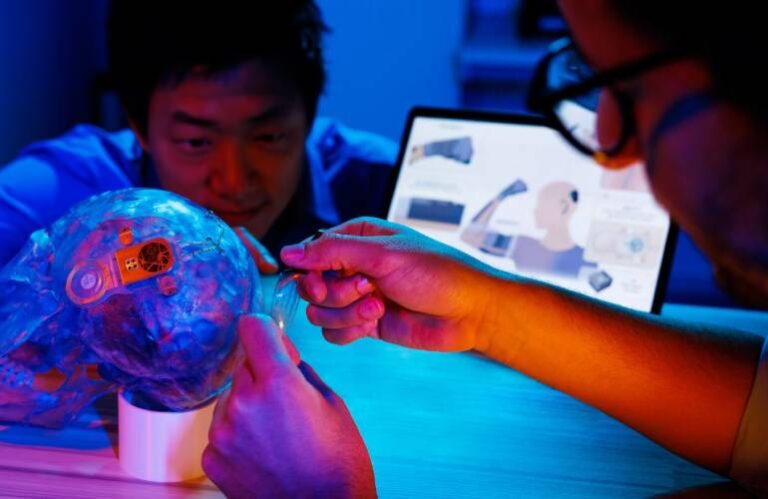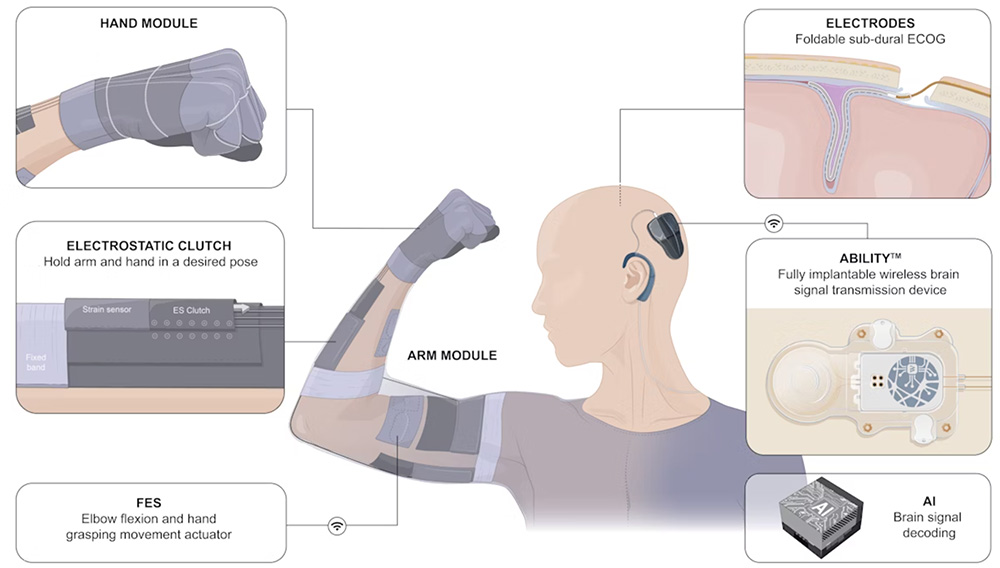|
Listen to this article  |

Researchers at the Wyss Center work on the Synapsuit exosuit project. | Source: Wyss Center
Researchers at the Wyss Center have an ongoing project to develop AI algorithms that use brain signals to control a lightweight exosuit.
The Synapsuit project aims to develop high-performance algorithms that decode complex brain signals. In turn, these signals control a lightweight, soft, wearable exosuit that supports arm and hand movement in real-time. The Wyss team collaborates with local and international partners on this project aimed at accelerating neuro-rehabilitation.
“Neuroscience is rapidly merging with AI, allowing us to discover important patterns hidden inside seemingly chaotic brain signals,” said Dr. Kyuhwa Lee, principal investigator, Wyss Center. “Using cutting-edge machine learning approaches, we aim to translate movement intentions into action for people living with movement disorders following spinal cord injury and stroke.”
Wyss plans to continue partnering to explore “new standards of neuro-AI technologies.” The group aims to assist people living with severe upper-limb motor disabilities to produce arm and hand movements. To achieve this, the team plans to gather large amounts of clinical data using flexible, high-density ECoG electrodes and develop new AI algorithms to decode the movement intentions of people experiencing motor disability.
More about the Wyss Center exosuit project

The components that make up the Synapsuit. | Source: Wyss Center
One partner in the exosuit project is Nuerosoft Bioelectronics, a brain-computer interface (BCI) technology maker.
“At Neurosoft Bioelectronics, we are committed to pushing the boundaries of BCI technology,” said CEO Dr. Nicolas Vachicouras. “Our cutting-edge, soft implantable electrodes offer a novel way to record signals from previously unexplored brain regions. By integrating these electrodes into the Synapsuit project, we aim to significantly improve the decoding of movement intentions, thereby taking a critical step towards restoring functional mobility to those who need it most.”
Combining the algorithms with a brain-controlled exosuit could accelerate neuro-rehab methods, Wyss says, by supporting the movement of those suffering from stroke and spinal cord injury.
The team records brain signals using soft, foldable, and flexible electrodes that conform to any neural tissues. They then feed the signals into the neuro-AI decoder that sends a command to the fully flexible, soft exosuit. The exosuit sends an electrical current through transcutaneous neurostimulation, controlling the muscle that directly moves the arm and the hand.
Combined with a special material called electrostatic clutch (ES-clutch), the exosuit allows the arm and hand to hold posture on demand without causing fatigue.
“We want to develop a highly usable, practical exosuit that can be used in daily life by people living with motor disability,” said Dr. Yun-Jae Won, principal investigator, Korea Electronics Technology Institute.
Editor’s Note: This article was syndicated from The Robot Report’s sister site Medical Design & Outsourcing.
Credit: Source link


Comments are closed.